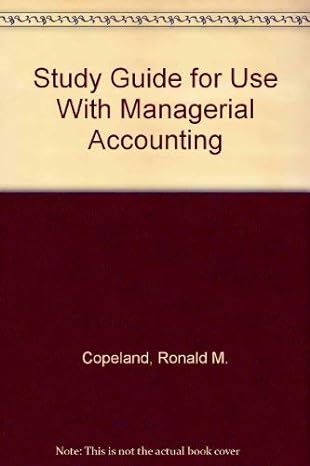Question
Weedor will receive $2 million today and $3 million one year from today. Weedor does not have any other assets. There are no transaction costs
Weedor will receive $2 million today and $3 million one year from today. Weedor does not have any other assets. There are no transaction costs or taxes, and all potential creditors and investors have all relevant information about investment payoffs. All these assumptions together are sometimes summarized by saying the capital markets are perfect. Also, assume that all future cash flows are known with certainty. For simplicity, assume that Weedor lives in a world that lasts only one year, and the rate of interest is 6 percent.
1) What is Weedors current wealth (equivalently, what is the present value of his assets)? How much money can he spend and consume today? How much of the money can he spend and consume one year from today if he consumes nothing today?
Suppose that instead of having a two-period endowment, Weedor has an initial endowment of $4 million. He decides to invest part of the $4 million in WeedorStop.com which he will build and manage. Use the data below for future cash flows (end of the year) that will result from an investment today. All payoffs are completely certain and known to all.
| Investment (Today) | Future Cash Flow (End of year) |
| 1.0 Million | 1.8 million |
| 2.0 million | 3.3 million |
| 3.0 million | 4.4 million |
| 4.0 million | 5.4 million |
2) How much of the $4 million should Weedor invest in the company? What happens to Weedors wealth when he makes the investment in WeedorStop.com?
3) Suppose that Weedor has a strong preference for current versus future consumption, and would like to consume at least $3.8 million immediately. Is this consumption possible, in light of the planned investment in WeedorStop.com?
4) Assume that Weedor does not have the $4 million endowments, to begin with, but still has the necessary skills to develop and operate WeedorStops Company. Should he still make the investment in the restaurant, and if so, how much? Assume that the only source of financing is a bank loan.
5) Since there are two types of individuals (savers and spenders). Considering all individuals prefer current consumption to future consumption, all other things equal, spenders have a relatively higher preference for current consumption. What if Weedor shares his ownership interest in the Weedor Corporation (cash of $4 million) with a widely-diffuse group of investors, savers and spenders? How much of the $4 million will the savers want to invest in the company, and how much will the spenders want to invest (assume whatever is not invested will be paid out as a dividend to investors). Will they reach a compromise, and if so what will it be?
6) The WeedorStop Corporation now consists of cash (remaining after the investment in WeedorStop) and WeedorStop Corporation. Assume that Weedor is contemplating another investment, namely to sell computer hard drive over the internet. This project will require a $2.5 million investment and will yield a future cash flow of $3.4 million. Should he undertake this investment? Assume that he does not want to use internal cash to finance the investment, nor does he want to use debt financing. There are currently 200,000 shares outstanding in the WeedorStop Corporation.
Step by Step Solution
There are 3 Steps involved in it
Step: 1

Get Instant Access to Expert-Tailored Solutions
See step-by-step solutions with expert insights and AI powered tools for academic success
Step: 2

Step: 3

Ace Your Homework with AI
Get the answers you need in no time with our AI-driven, step-by-step assistance
Get Started


